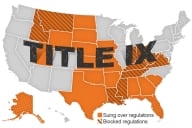You have /5 articles left.
Sign up for a free account or log in.

Florida State University players and football coaching staff led a unity walk in support of the Black Lives Matter movement last June.
Don Juan Moore/Contributor/Getty Images
In the wake of George Floyd’s murder by a Minneapolis police officer last May, college and university presidents across the country issued statements and sent emails to members of their campuses decrying Floyd's death and acknowledging the shock, pain and anger felt by many Americans. Their varied responses to the nationwide calls for racial justice included commitments to take action to address racial and economic inequities in higher ed and on their campuses.
Platitudes about diversity and inclusion were in abundance. Pledges to lead the country on a different path were on full display.
Now, just over a year later, a new report from NASPA, the professional organization for student affairs administrators, and the National Association of Diversity Officers in Higher Education, examines the strengths and weaknesses of many of those statements and takes a look at who drafted them. The authors of the report -- “Moving From Words to Action: The Influence of Racial Justice Statements on Campus Equity Efforts” -- also surveyed a number of college and university leaders about the actions they took just after Floyd’s death and in the subsequent months.
From a sample of 300 NASPA member institutions, the authors found that 230 colleges and universities issued statements in the two-week time period following Floyd’s death. Those statements were coded using three levels, with level II representing the strongest statement elements and level 0 representing the weakest statement elements.
Most of the statements -- 95 percent -- named George Floyd, but only 46 percent mentioned Ahmaud Arbery and 42 percent named Breonna Taylor, who were also killed in 2020. Six in 10 of the statements included mentions of discrimination against the Black and/or African American community, while just over half discussed institutional or structural racism.
Only 24 percent of the statements discussed police violence against the Black and/or African American community. About one in 10 statements included actionable next steps for the institution.
Statements that included level I themes and elements were not as strong as the messages with more direct language, such as explicit mentions of discrimination or institutional racism. Many statements included mentions of solidarity; equality, respect and fair treatment for all; greater inclusion; and past or continuing existing institutional diversity or inclusion efforts. A smaller number of messages mentioned COVID-19 racial disparities.
Weaker statements contained level 0 elements, such as mentions of “good cops” or violent protests and riots.
“Level zero would be things that we interpreted as being potentially harmful to students or the campus community,” said Alexa Wesley, director of research and strategy at NASPA and co-author of the report. “Things that seem to take away from the true issue at hand.”
The 300-institution sample included 100 public four-year institutions, 100 private four-year institutions and 100 public two-year institutions. About 87 percent of four-year publics and 92 percent of four-year privates issued statements, but only half of the public two-year colleges in the sample did the same.
Predominantly white institutions and minority-serving institutions also issued statements at similar rates, the report showed, but they included different elements. For example, predominantly white institutions more often included language about equality, respect and fair treatment for all compared with the statements from minority-serving institutions. Minority-serving institutions were more likely to mention institutional and structural racism and discrimination against Black and/or African American people.
Most of the statements -- 85 percent -- were sent out by college and university presidents, but a variety of college officials chipped in to draft the statements, survey results showed. Vice presidents of marketing and communications helped write two-thirds of the statements, chief diversity officers assisted with half of the statements, vice presidents for student affairs helped with 45 percent of statements, and provosts helped write 25 percent of statements.
Only 2 percent of the statements were drafted with student or faculty input, which Wesley said is a problem.
“As we’re emphasizing the importance of elevating student voices … it’s important to include them more in the statement development process, but also in your action plans,” she said.
Ivory Achebe Toldson, a professor of human development and psychoeducational studies at Howard University and co-author of the book Campus Uprisings: How Student Activists and Collegiate Leaders Resist Racism and Create Hope, said it’s also important for college leaders to consider what Black students and employees have already pointed out to them about racism at their institutions.
“A lot of these institutions have already received things that Black students and faculty and staff have presented to them that would make their experiences better,” Toldson said. “They shouldn't disconnect those types of things from a statement that is to honor someone who died because of police brutality.”
Alumni, campus police chiefs and others off campus were not consulted on any of the statements put out by survey respondents, the report showed.
Members of the executive team or cabinet at 49 colleges and universities issued follow-up statements after their initial statements were made. Most of those follow-ups -- 63 percent -- articulated a plan for change or action. About half followed up on what was shared in the first statement, and nearly a third responded to criticism of the first statement.
Some college leaders who rushed to issue initial statements were criticized for being tone-deaf or too cautious.
“Everyone involved would agree that our statement was not as well-crafted as it might have been even a couple days later. There was dissatisfaction expressed with the content, but we were committed to a swift response,” one survey respondent wrote. “Perfect timing and impact matching intent were difficult to maximize at that moment.”
Toldson said college leaders should always choose quality over timeliness at such important moments.
“Any time the statement is obligatory, it runs the risk of it being less than sincere,” he said. “I think that was the case last year.”
The NASPA report also surveyed institutions about what types of action items colleges and universities undertook following Floyd’s death. The authors divided the responses into seven categories: resource investment, hiring and recruitment, education or training, data assessment, pedagogy, public statues and buildings, and campus police reform.
In the eight months following Floyd’s death, more than a third of survey respondents said they began funding new initiatives related to diversity, equity and inclusion work. About a quarter of institutions are seeking grant funding and donations for DEI-related initiatives; 22 percent of institutions set up institutional racial equity committees; 21 percent hired additional staff for the central office of equity, diversity and inclusion; and 18 percent are developing DEI education or training resources for students.
One factor the report doesn’t touch on is student perspective, said Jill Dunlap, senior director of research, policy and civic engagement at NASPA and co-author of the report. She was surprised that a recent survey by Inside Higher Ed, College Pulse and Kaplan showed that only 45 percent of students said that officials at their institution sent an email to students following Floyd’s death, and that only 12 percent reported their institutions developed an action plan related to racial justice. NASPA’s data showed that a greater percentage of colleges have undertaken such efforts.
“I think there’s a disconnect,” Dunlap said. “How are students being made aware of what’s happening with these efforts? Because it clearly matters to them.”








